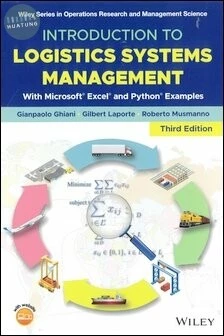
| 定價: | ||||
| 售價: | 2210元 | |||
| 庫存: | 已售完 | |||
| LINE US! | ||||
| 此書為本公司代理,目前已售完,有需要可以向line客服詢問進口動向 | ||||
| 付款方式: | 超商取貨付款 |

|
|
| 信用卡 |

|
||
| 線上轉帳 |

|
||
| 物流方式: | 超商取貨 | ||
| 宅配 | |||
| 門市自取 |
為您推薦

類似書籍推薦給您
【簡介】 The Sixth Edition of Supply Chain Logistics Management presents Logistics in the context of integration within a firm's Supply Chain Strategy and Operations. The framework of Supply Chain Management is initially presented by creating a foundation for in-depth study of the five logistics operational components in Part Two. Challenges and strategies related to design and operational integration of logistics within a global supply chain are discussed in Part Three. Part Four focuses on administrative challenges related to cross organizational collaboration, performance measurement, and concludes with the challenges of managing risk and achieving sustainability. An essential feature of the overall presentation is the integration of topical materials and examples into the Supply Chain Logistics value creation process. Text materials are supported by study and challenge questions as well as contemporary cases. The presentation integrates the discussion of information technology throughout. Illustrations and examples highlight how firms deal with operational challenges and use logistics performance to gain competitive advantage. 【目錄】 PART I: SUPPLY CHAIN LOGISTICS MANAGEMENT Ch 1 21st Century Supply Chains Ch 2 Supply Chain Information Technology Ch 3 Logistics Ch 4 Customer Accommodation PART II: SUPPLY CHAIN OPERATIONS Ch 5 Integrated Operations Planning Ch 6 Procurement and Manufacturing PART III: SUPPLY CHAIN LOGISTICS OPERATIONS Ch 7 Inventory Ch 8 Transportation Ch 9 Warehousing, Materials Handling, and Packaging PART IV: SUPPLY CHAIN LOGISTICS DESIGN Ch10 Global Supply Chains Ch11 Network Design PART V: SUPPLY CHAIN LOGISTICS ADNIMISTRATION Ch12 Relationship Management Ch13 Performance Management Ch14 Supply Chain Trends

類似書籍推薦給您

類似書籍推薦給您
【簡介】 The sixth edition includes many changes, the most obvious being that there are four additional chapters: terminal operations, transportation of dangerous goods, transportation of refrigerated goods, and cross-border trade. These chapters were added because several faculty members had requested that they be added. I hope that they meet their expectations. For the first time, there are two chapters of the fifth edition that were eliminated-temporarily. These chapters covered quality management and inventory management, and were better suited for an international-supply-chain management textbook. This textbook is in preparation, and will be published in the summer of 2022. For those faculty members who would like to include these chapters in a course in which they have adopted the sixth edition of International Logistics, both of these chapters are downloadable, at no charge, from the publisher's website. As with previous editions, the remainder of the text has been completely updated, with new tables, new examples, and new photographs. 【目錄】 1. International Trade. 2. International Logistics and Supply Chain Management. 3. International Infrastructure. 4. International Methods of Entry. 5. International Contracts. 6. Terms of Trade or Incoterms Rules. 7. Terms of Payment. 8. Managing Transaction Risks. 9. International Commercial Documents. 10. International Insurance. 11. International Ocean Transportation. 12. International Air Transportation. 13. International Land and Multimodal Transportation. 14. International Terminal Operations 15. Packaging for Export. 16. International Warehouses and Distribution Centers. 17. International Transportation of Dangerous Goods. 18. International Transportation of Refrigerated Goods. 19. International Logistics Security. 20. Customs Clearance. 21. Cross-Border Trade. 22. Developing a Competitive Advantage.

類似書籍推薦給您
【簡介】 Description Introduction to Logistics Systems Management provides an in-depth introduction to the methodological aspects of planning, organization, and control of logistics for organizations in the private, public and non-profit sectors. Based on the authors’ extensive teaching, research, and industrial consulting experience, this classic textbook is used in universities worldwide to teach students the use of quantitative methods for solving complex logistics problems. Fully updated and revised, the third edition places increased emphasis on the complexity and flexibility required by modern logistics systems. In this context, the extensive use of data, descriptive analytics, predictive models, and optimization techniques will be invaluable to support the decisions and actions of logistics and supply chain managers. Throughout the book, brand-new case studies and numerical examples illustrate how various methods can be used in industrial and service logistics to reduce costs and improve service levels. The book: includes new models and techniques that have emerged over the past decade; describes methodologies for logistics decision making, forecasting, logistics system design, procurement, warehouse management, and freight transportation management; includes end-of-chapter exercises, Microsoft® Excel® files and Python® computer codes for each algorithm covered; includes access to a companion website with additional exercises, links to video tutorials, and supplementary teaching material. To facilitate creation of course material, additional LaTeX source data containing the formulae, optimization models, tables and algorithms described in the book is available to instructors. Introduction to Logistics Systems Management, Third Edition remains an essential textbook for senior undergraduate and graduate students in engineering, computer science, and management science courses. It is also a highly useful reference for academic researchers and industry practitioners alike. 【目錄】 Table of Contents 1 Introducing Logistics 2 Forecasting Logistics Data 3 Designing the Logistics Network 4 Selecting the Suppliers 5 Managing a Warehouse 6 Managing Freight Transportation Index